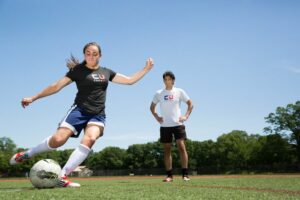Since the majority of our sports-driven medias are centered around males, it’s typically a safe assumption that they find themselves injured more than the female gender. However, did you know that it’s actually woman that are more likely to sustain a common sports injury? Dr. Robert Shmerling, M.D. penned an intricate look at just how susceptible these athletes, young and old, can be. From knee injures to stress fractures, loads of these serious injuries happen because of the general differences between bodies in the two genders. Dr. Shmerling says:
There is probably a combination of factors that contribute to the higher incidence of injuries among female athletes. And we have more theories than actual answers. The most common explanation is that it’s due to basic differences between the bodies of men and women. For example, the typical female athlete, as compared with her male counterpart, has:
- higher estrogen levels, along with less muscle mass and more body fat
- greater flexibility (due to looser ligaments) and less powerful muscles
- a wider pelvis, which alters the alignment of the knee and ankle
- a narrower space within the knee for the ACL to travel through
- a greater likelihood of inadequate calcium and vitamin D intake.
After that, Dr. Shmerling discusses a few ways woman can specifically train in order to limit potential injury — from ankles braces to hamstring-specific workouts, the future outlook doesn’t have to be bleak! Additionally, we’ve written about ACL injuries in females on our Training Center, so we’d like to highlight it again; for example:
Plyometrics, or jump training, involves lengthening and contracting your muscles quickly to exert maximum force. These exercises focus on the explosive qualities that most need to succeed on the pitch. One of the main causes of ACL injuries are rapid changes in speed and direction, a necessity in soccer, so stick with these exercises.
As always, you can find our entire entry right over here, but Dr. Shmerling’s contributions are really valuable assets to the conversation. Train, exercise, and grow as an athlete — but, most importantly, stay healthy! Harvard Health Blog — The gender gap in sports injuries Tips for ACL Injury Prevention — CoachUp Training Center
How useful was this post?
Click on a star to rate it!
Average rating 0 / 5. Vote count: 0
No votes so far! Be the first to rate this post.




